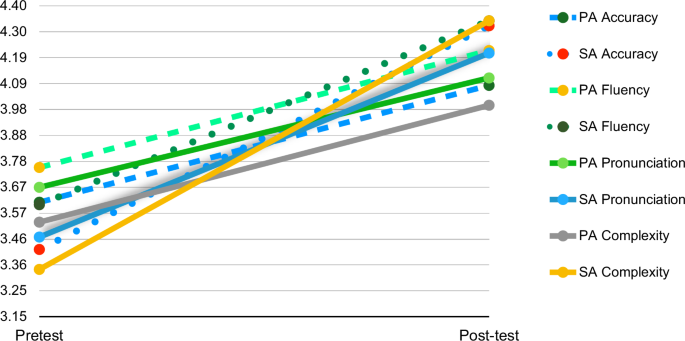Cultivating proficient and efficacious L2 English speakers via VoiceThread-mediated self- and peer assessments

Theoretical framework
This study is grounded in two theoretical frameworks that inform the application of online self- and peer assessments to influence English speaking and self-efficacy: Bandura’s (1986, 1997) self-efficacy theory and Vygotsky’s (1978) sociocultural theory. These frameworks have been extensively applied in L2 speaking research (Al-khresheh and Alkursheh, 2024; Kim, 2024; Li et al., 2024), providing a comprehensive lens for understanding how different assessment modalities influence language learning outcomes and self-efficacy development.
Bandura’s self-efficacy theory posits that learners’ beliefs about their capabilities significantly influence their performance through four primary sources: mastery experiences, vicarious experiences, social persuasion, and emotional states. First, mastery experiences, the most crucial source of self-efficacy, involve accomplishing a task (Usher and Pajares, 2008). Mastery experiences are particularly influential in language learning contexts where repeated successes build confidence and competence (Li et al., 2024). In this study, VoiceThread-mediated SA provided learners with structured opportunities to review and evaluate their own speaking performances, which allowed them to track their progress over time, identifying both improvements and areas needing attention. The asynchronous nature of VoiceThread allowed learners to attempt multiple recordings until satisfied, potentially fostering positive mastery experiences.
Second, vicarious experiences occur through observing others’ successes and failures, mainly when the observed individuals are considered similar to the observers themselves (Schunk and Usher, 2019; Wang and Li, 2019). Students gain exposure to various speaking models in PA conditions by watching their peers’ recorded speeches. This exposure serves dual purposes: stronger performance provides aspirational models, while observing peers at similar proficiency levels helps normalize the learning process and demonstrates achievable progress. Third, social persuasion through verbal encouragement and feedback influences self-efficacy (Aben et al., 2022). PA operationalizes this source through structured peer feedback, while SA incorporates elements of self-persuasion through guided reflection protocols. VoiceThread’s multimedia commenting features enable detailed, specific feedback that can reinforce positive self-beliefs while providing constructive suggestions for improvement. Fourth, emotional and physiological states affect how individuals judge their capabilities (Phan and Ngu, 2016). VoiceThread’s asynchronous environment potentially reduces speaking anxiety by removing immediate audience pressure. Both SA and PA conditions are designed to create low-anxiety evaluation environments where L2 learners can develop comfort with speaking English over time.
Lastly, complementing self-efficacy theory, Vygotsky’s sociocultural framework emphasizes the social nature of language learning and development. This framework is particularly relevant to understanding how PA facilitates L2 speaking development through social interaction and collaborative evaluation. Furthermore, both assessment conditions incorporate structured evaluation rubrics and guiding questions that scaffold learners’ developing ability to assess speaking performance. This scaffolding gradually develops students’ metacognitive awareness and self-regulated learning. In short, the differential engagement of self-efficacy sources and sociocultural learning mechanisms between SA and PA conditions may explain potential variations in speaking proficiency and self-efficacy outcomes.
Self-efficacy and sociocultural theories offer a solid foundation for understanding how assessment practices impact the development of L2 speaking and self-efficacy. However, substantial pedagogical challenges remain in applying these concepts to online learning settings. It is still unclear how to optimize online assessments to activate various sources of self-efficacy while maintaining the social learning advantages highlighted by sociocultural theory. This study addresses this challenge by exploring how different assessment types (self- versus peer) delivered via VoiceThread may vary in their capacity to engage those theoretical mechanisms to facilitate L2 speaking improvement and boost self-efficacy.
Self-efficacy and L2 speaking
Learning to speak a second language well is far more complicated than just activating the language learner’s cognitive processing and memorizing the grammar. Based on Bandura’s social learning theory (1997), affective factors such as self-efficacy also play a crucial role in shaping EFL learners’ oral proficiency. EFL teachers have frequently observed in their classrooms that students with poor proficiency in English are mostly those who do not believe they can learn English well. Recent research has consistently shown a strong positive correlation between learners’ self-efficacy and their EFL achievements (Kim, 2024; Li et al., 2024).
Bandura (1986) defined “self-efficacy” as learners’ self-belief in learning particular tasks or skills. Learners with high self-efficacy tend to face challenges rather than avoid them, and are able to recover quickly from setbacks. Therefore, Bandura proposed that “the stronger the perceived self-efficacy, the higher the goal challenges people set for themselves” (1986, p. 362). Research in this area continues to validate the critical implications of self-efficacy theory in academic settings, showing that learners’ self-perceived efficacy affects their academic achievement (Al-khresheh and Alkursheh, 2024; Wicaksono et al., 2023). In L2 learning specifically, recent research has demonstrated that anxiety and self-efficacy influence students’ speaking skills (Wijaya, 2024), while public speaking self-efficacy has been found to predict achievement (McNatt, 2019).
In addition, literature on the relationship between self-efficacy beliefs and performance implies that self-efficacy is susceptible to change via positive experiences. Studies investigating self-efficacy belief change have consistently argued that self-efficacy beliefs are flexible and subject to development, rather than being fixed (Al-khresheh and Alkursheh, 2024; Bandura and Schunk, 1981; Kim, 2024). The critical issue is developing instructional activities and novel applications to enable students to experience success and to reconstruct their self-efficacy perceptions accordingly. Goal setting and online technology use have been identified as effective mechanisms for cultivating self-efficacy beliefs (Basileo et al., 2024; Wang and Sun, 2024).
In brief, prior studies suggested that the relationship between mastery experience and self-efficacy is cyclical and two-way: greater efficacy leads to more significant effort and persistence, resulting in better performance and enhanced efficacy. While much research has focused on learners’ perceived self-efficacy in foreign language learning (Li and Zhang, 2023; Sengul and Buyukkarci, 2023), there remains a gap in understanding how specific instructional strategies, such as VoiceThread-mediated self- and peer assessment, might affect L2 speaking self-efficacy. In EFL classrooms, adopting alternative assessment methods such as self- and peer evaluation has proven valuable for promoting goal setting and enhancing learner autonomy (Ashraf and Mahdinezhad, 2015; Liao, 2023; Wicaksono et al., 2023). These assessment practices may play a crucial role in developing students’ self-efficacy. More empirical studies are needed to understand how these assessment practices play a crucial role in developing students’ self-efficacy by activating multiple sources of efficacy information within a sociocultural framework of learning and development.
Theoretical and empirical studies on self-efficacy in L2 speaking have pointed out a significant pedagogical challenge. Although self-efficacy beliefs are malleable and crucial for speaking development, less is known about how specific instructional approaches can effectively cultivate these beliefs in online environments. This study’s second research question intended to fill the gap by examining how different VoiceThread-mediated assessment types might affect L2 speaking self-efficacy. Understanding these relationships could help educators design more effective online speaking activities that simultaneously develop linguistic competence and strengthen self-efficacy beliefs.
Self- and peer assessment in L2 learning
Recent studies on self- and peer assessment in language learning have consistently demonstrated their positive impact on learners’ language proficiency, self-efficacy, and autonomy. For instance, research by Aldosari and Alsager (2023) highlighted how SA improves language skills and fosters resilience, creativity, and learner autonomy among EFL learners. These findings align with earlier studies that emphasized the role of SA in promoting metacognitive skills and self-directed learning (Alibakhshi and Sarani, 2014; Chen, 2010). Research suggests that these assessment practices can significantly enhance oral language skills. Alibakhshi and Sarani (2014) studied how SA affects speaking fluency and accuracy. They worked with 60 EFL students at pre- and upper-intermediate levels, split between a control and an experimental group. Their pre- and post-test results confirmed that SA boosted speaking accuracy and fluency, suggesting its value for students and teachers. SA has proven particularly beneficial in speaking classes.
Besides SA, PA has also been shown to contribute significantly to language development. A study by Esfandiari and Tavassoli (2019) demonstrated that PA enhances learners’ oral proficiency and boosts their confidence and social skills by fostering a sense of accountability. Joo (2016) examined students’ ability to evaluate both their oral and peers’ work. The findings highlighted that speaking improvement stems from the assessment and students’ active involvement in the evaluation process. Similarly, research by Ashraf and Mahdinezhad (2015) found that PA activities positively impacted learner autonomy in speaking tasks. The collaborative nature of PA allows students to reflect on their peers’ performances while improving their own. Moreover, Zarei and Usefli (2019) investigated how different assessment types affected Iranian EFL learners’ general and academic self-efficacy. After taking the Primary English Test (PET), 94 students were divided into three groups, each experiencing self-, peer, or teacher assessment. Students completed general and academic self-efficacy questionnaires before and after the intervention. ANCOVA analysis revealed that while the assessment types had similar impacts on general self-efficacy, self- and peer assessment proved more effective than teacher assessment for academic self-efficacy. Interestingly, self- and peer assessment showed comparable effectiveness in boosting academic self-efficacy.
Studies comparing the effects of self- and peer assessment on second language speaking have revealed that both assessment methods can positively impact learners’ speaking skills, although their effects may differ across implementation contexts. Imani (2021) found that self- and peer assessment had comparable positive effects on both impulsive and reflective EFL learners’ speaking ability, with no significant interaction between assessment type and cognitive style. However, Maleki et al. (2024) observed that SA was more effective than PA in terms of improving ESP students’ speaking ability and reducing their second language speaking anxiety. This finding was echoed by Zheng et al. (2024), who pinpointed the optimal sequence for integrating SA first for high-anxiety learners versus introducing PA for low-anxiety learners. Zheng et al. (2024) studied AI-supported formative assessment in English public speaking with three key findings: peer assessment led to higher social engagement than automated assessment, students had mixed views on different assessment types, and both self- and peer assessment improved speaking skills, with varying impacts on anxiety, engagement, and specific language abilities. The study highlights the limitations of automated assessment in replacing peer interaction for language learning.
However, challenges related to the reliability of self- and peer assessment persist. Studies have identified issues such as assessor bias or evaluation inconsistency (Singh, 2015; Yinjaroen and Chiramanee, 2011). For example, some learners overestimate or underestimate their abilities compared to teacher assessments (Patri, 2002). In light of these challenges, implementing structured guidelines is key to mitigating such issues. Falchikov (2007) suggested that providing clear criteria and training can improve the accuracy of both self- and peer assessments. For example, Chen’s (2010) study showed that Chinese university students’ ratings aligned more closely with teachers’ assessments after two rounds of practice and guidance.
To explicitly compare SA and PA, Table 1 summarizes the language-learning-related benefits and the limitations of SA and PA.
In short, the literature indicates that both SA and PA offer distinct yet complementary benefits for L2 speaking development. SA appears particularly effective for improving speaking accuracy/fluency and reducing anxiety (Maleki et al., 2024), whereas PA contributes to social engagement and collaborative learning (Zheng et al., 2024). Both assessment types show promising effects on learners’ academic self-efficacy (Zarei and Usefli, 2019); however, their relative effectiveness may vary depending on learner characteristics, such as anxiety levels (Zheng et al., 2023). Most existing studies have examined these assessment types in traditional classroom settings, leaving their comparative effects largely underexplored in online environments, which leads to the first research question. Moreover, considering the implementation challenges identified by the previous research, including assessment reliability and peer feedback quality (Singh, 2015; Zheng et al., 2024), online platforms have emerged as a feasible medium to mitigate the drawbacks of alternative assessments with their affordance of providing clear guidance, convenient training, and constant feedback for optimal self- and peer assessment. This potential of online platforms for enhancing SA and PA practice necessitates investigating how tools such as VoiceThread might mediate these assessment types to optimize L2 speaking development.
Online assessment in L2 speaking
Online assessment, or e-assessment, refers to using digital tools to deliver, store, and grade student performance in various forms, including text, audio, video, and images. It can be conducted synchronously or asynchronously for individuals or groups (Crisp, 2011). Recent studies have documented the positive impact of online assessment on L2 speaking skills. One effective tool for online assessment is VoiceThread, which harnesses unique affordances to enhance oral proficiency through self- and peer assessment. The platform’s asynchronous feedback system enables assessors to provide targeted commentary at specific moments in speakers’ oral productions. At the same time, its multimodal interface combines audio, visual, and text-based interactions to support comprehensive assessment.
For example, in Pagkalinawan’s (2021) study, students who recorded and assessed their presentations via VoiceThread improved their vocabulary, grammar, fluency, and pronunciation. The platform’s multimodal features allowed students to receive feedback in multiple formats. The asynchronous nature of the tool boosted their confidence by enabling them to review and respond to feedback multiple times, leading to enhanced preparation and delivery skills. Similarly, Salehi and Rowan (2015) found that VoiceThread’s multimodal commenting features facilitated detailed peer assessment, allowing students to critically evaluate each other’s work through oral and written feedback, improving their speaking performance. Moreover, Liao’s (2023) study on online self-and peer assessment demonstrated how VoiceThread’s combination of visual, audio, and text-based interaction supported the development of learner autonomy and improved L2 English speaking skills. Participants in the experimental group who engaged with these multimodal assessment features outperformed the control group in speaking performance and demonstrated a stronger sense of learner autonomy.
Studies examining students’ perceptions of online speaking assessments have revealed both platform-specific benefits and challenges. Students applauded VoiceThread for its multimodal feedback options and the flexibility of working on assessments at their convenience (Amalia, 2018; Komang, 2021; Wibowo and Novitasari, 2021). Similarly, Çetin Köroğlu’s (2021) study with 52 English-major university students in Turkey revealed that participants using digital formative assessment tools outperformed those taking traditional speaking tests, attributing this success to the opportunity for learner self-reflection and peer collaboration through task completion.
However, it is important to note that VoiceThread, like any tool, has its challenges. For instance, the delayed feedback from the asynchronous nature of the platform could disrupt the assessment flow. Giving specific feedback on speaking skills in a digital format can be challenging for L2 speakers, and so may require modeling and training. While some challenges stem from technical aspects of oral recording and playback quality, others involve pedagogical considerations, such as providing adequate training, keeping assessment consistent across different review sessions, and ensuring effective use of multimodal feedback tools. In short, while online speaking assessment platforms offer enhanced opportunities for detailed feedback and engagement in second language acquisition, successful implementation requires careful attention to platform-specific affordances and limitations
The literature on online speaking assessment highlights both opportunities and challenges in implementing digital tools for L2 speaking development. While platforms such as VoiceThread offer unique affordances for multimodal feedback and flexible assessment opportunities, successful implementation requires careful consideration of both technical and pedagogical factors. This connects directly to all three research questions in this study, as how VoiceThread-mediated assessment types affect both learning outcomes and learner perceptions is examined.
The present study
Despite growing interest in online speaking assessment for second language learners, significant gaps exist in understanding how theoretical frameworks, assessment practices, and digital platforms intersect to support L2 speaking and self-efficacy development. First, while self-efficacy theory and sociocultural theory suggest different mechanisms through which assessment practices might influence learning outcomes, empirical evidence about how these mechanisms operate in online environments remains scarce. Second, although research demonstrates the potential of both self- and peer assessment for L2 speaking development, educators face continued challenges in implementing these practices effectively in online contexts. Third, while digital platforms such as VoiceThread offer promising features for speaking assessment, a better understanding of how to leverage these tools to optimize speaking development and self-efficacy growth is needed. This study intended to fill these gaps by addressing the following three research questions:
- 1.
What are the effects of VoiceThread-mediated self-assessment compared to peer assessment on the oral proficiency development of L2 English speakers?
- 2.
What are the effects of VoiceThread-mediated self-assessment compared to peer assessment on the speaking self-efficacy of L2 English speakers?
- 3.
What are L2 English speakers’ perceptions of VoiceThread-mediated self- and peer assessments after participating in them for 1 year?
Source link




